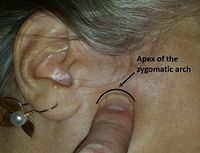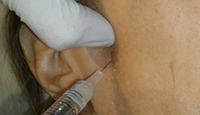◔
TMJ Injection
From WikiMSK
This article is a stub.
| TMJ Injection | |
|---|---|
| Indication | TMJ Pain |
| Syringe | 1mL |
| Needle | 27-gauge 3.2 mm |
| Injectate | steroid, 20% dextrose, or PRP |
| Steroid | 20mg triamcinolone |
| Volume | 1mL |
Technique
Landmark Guided

Injection entry site, located 0.75 to 1 cm below the apex of the zygomatic arch.[1]

Injection angle of 45° cranial and 10° posterior, using a 1-in 30-G needle.[1]
- Relaxed, closed-mouth approach.
- Place finger in the depression under the zygomatic arch, against the zygoma, and draw a curved line approximating the bottom of the arch.
- Ask the patient to open and close their mouth and confirm the location of the posterior mandible. Feel the head of the mandible pass anteriorly underneath your finger and then resume its posterior position
- Needle (27-gauge 3.2 mm) entry is 1cm below the apex of the zygomatic arch with slight 10° posterior angulation, and 45° of cephalad angulation
- If the needle inadvertently made bony contact shallower than 25 mm, withdraw the needle several mm and redirect superiorly to avoid the mandibular condyle.
- After aspiration, inject 1 mL was at 25 mm depth
Ultrasound Guided
- Challenging, consider using if failed landmark guided injection
- Use a high-frequency linear small footprint probe
- Place longitudinally over the TMJ.
- Visualise superficial temporal vessels overlying the joint.
- Move probe cranially to allow needle to enter skin
- Enter joint space in plane with 23G needle
- Inject solution into joint space
Complications
Damage to the collateral ligaments of the disc and the adjacent soft tissue, facial nerve palsy.
Aftercare
Avoid NSAIDs if prolotherapy or PRP.
References
Literature Review
- Reviews from the last 7 years: review articles, free review articles, systematic reviews, meta-analyses, NCBI Bookshelf
- Articles from all years: PubMed search, Google Scholar search.
- TRIP Database: clinical publications about evidence-based medicine.
- Other Wikis: Radiopaedia, Wikipedia Search, Wikipedia I Feel Lucky, Orthobullets,


